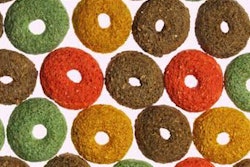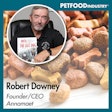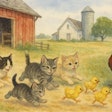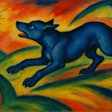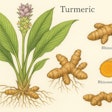For the past decade, there has been an increasing number of "novel protein ingredient" foods marketed in the petfood industry. Originally, these were merchandised in the veterinary trade for elimination diets intended as nutritional support for animals with recalcitrant food hypersensitivities. Today they are being featured as more mainstream products and promoted for their connection to the "Wild," "Primordial" and "Ancestral" thematic past of our now domesticated furry companions. Many of them feature meats from "near-domestic" herbivorous species like deer (venison), rabbit and buffalo, or fish and fowl species like salmon, trout and duck.
We have discussed salmon previously (October 2011), and we will save trout and duck for another day. Meat from deer, rabbit and buffalo has not been a big part of commercial petfoods until recently, but one can easily imagine them as prey for our pets' wild ancestors. A glamorous phantasmagorical story indeed. But, to fast forward into our current reality we should probably understand these meats a bit better if they are going to be a part of the petfood ingredient landscape for the foreseeable future.
These meats conjure images of hunting wild game. But, does that make for a sustainable supply? Estimates are hard to come by because most consumption of game is local or regional with only limited information reported to government agencies. Further, systems to support the accumulation of truly wild supplies sufficient to provide for industrial production of petfoods on a national scale don't really exist. Despite this, these meats are getting into the supply chain. So how is this happening?
Quite simply, they are farm raised, not wild per se. Case in point, deer farming is big business in New Zealand with estimates at 15,249 metric tons of venison and 3,984 metric tons of venison co-products exported in 2012, according to the Deer Industry News (Issue 55; Aug./Sept. 2012). Much of the venison going to Europe and the US, and most of the venison co-product, stream to the petfood market. Rabbit meat production in 2012, according to FAOSTAT, was 1,833,843 metric tons, with China the leading producer followed by Venezuela, Italy, Korea and Spain. Most of the US imports are from Canada.
For "buffalo" meat, the FAOSTAT (2012) reports global production at 3,597,340 metric tons, with India leading Pakistan, Egypt, China and Nepal. Of course those aren't the American bison buffalo that many of us might think about. In the US, the number of bison processed into retail last year was 51,500 (head; USDA, 2013) and accounted for around US$280 million at retail in 2010, according to the National Buffalo Association. So, depending upon exports, how the products are marketed and seasonal factors there is a growing modern sustainable supply chain for these meats.
As part of the "image" associated with these meats there have been hints that they appeal to the animal's sense of taste or that there are some unique nutritional characteristics. Is there any substance to this? Generally speaking, these meats are promoted to the human foods market as leaner, and thereby healthier, than comparable domestic meats from beef or pork. If one reviews the standard nutritional databases, this seems to be confirmed.
However, the nutrient composition of the ingredients available to the petfood industry-mechanically separated meats or "natural fall"-is quite different from what one would find in the USDA nutrient database or a grocery meat case. These ingredients are derived from trimmings, mechanical separation of meat and fat from bones, and/or various organ meats, intestines and glands. The composition of these "game meats" runs 65% to 75% moisture, 10% to 12% protein, 6% to 15% fat and 0.5% to 5% ash. In other words, they are comparable to most domestic "mechanically deboned meats" in our petfood ingredient supply chain; albeit substantially more expensive.
Some suppliers might have much tighter controls over the consistency of this composition than others, but one can see large swings in composition from lot to lot and supplier to supplier. So, a very active quality control process is imperative; formulas should take into account these fluctuations with some complementary ingredients, and it is best to limit dependence on these ingredients to deliver the predominant share of any one vital nutrient. With all these exceptions it seems somewhat impractical that we go to such efforts; but, the market message for the consumer is very appealing.
However, we need to spend a few more resources, collectively, to verify the nutritional value of these ingredients, and if possible find unique qualities that benefit dogs and cats to help justify the added cost they represent as we continue to create the next generation of petfoods.





